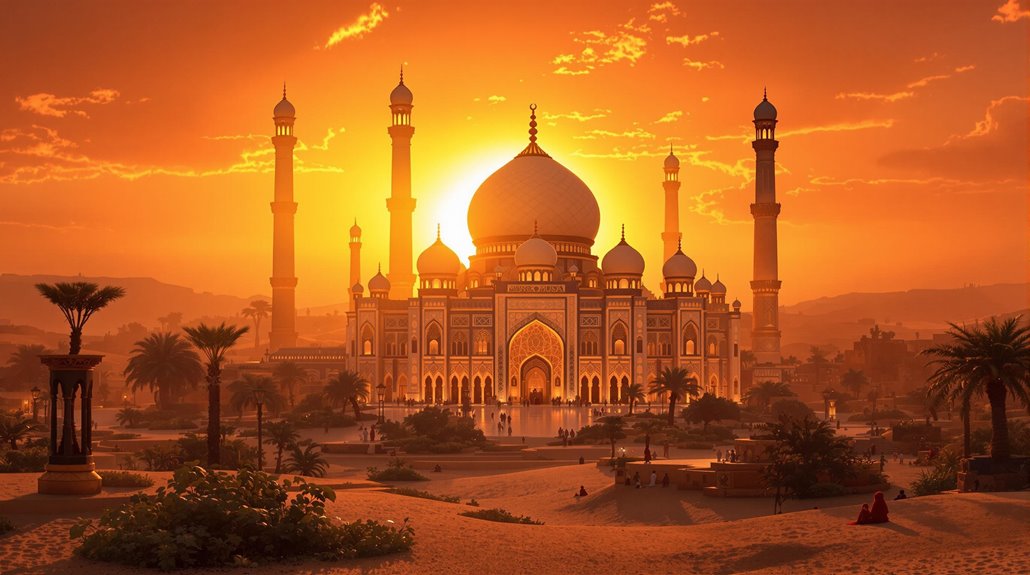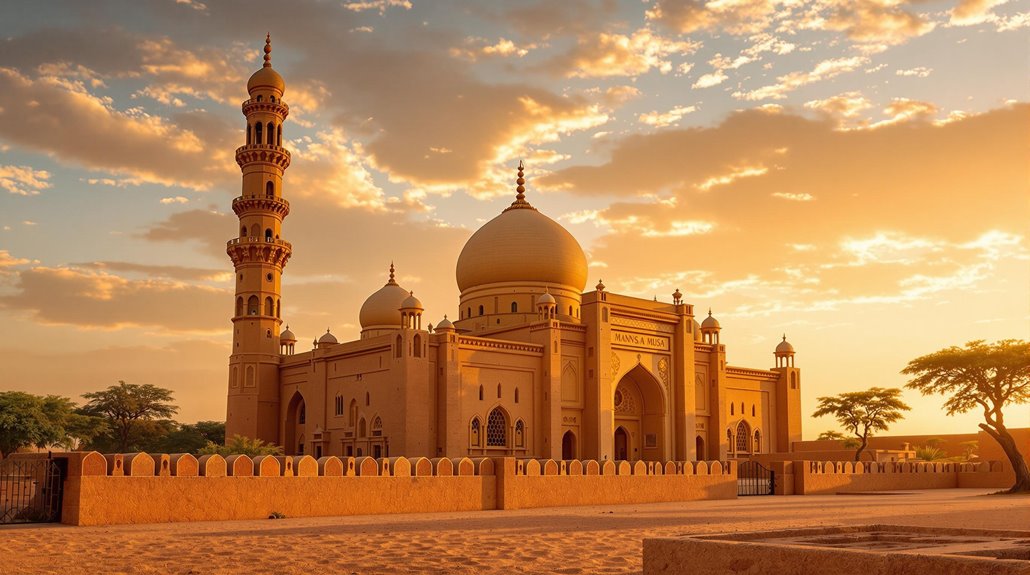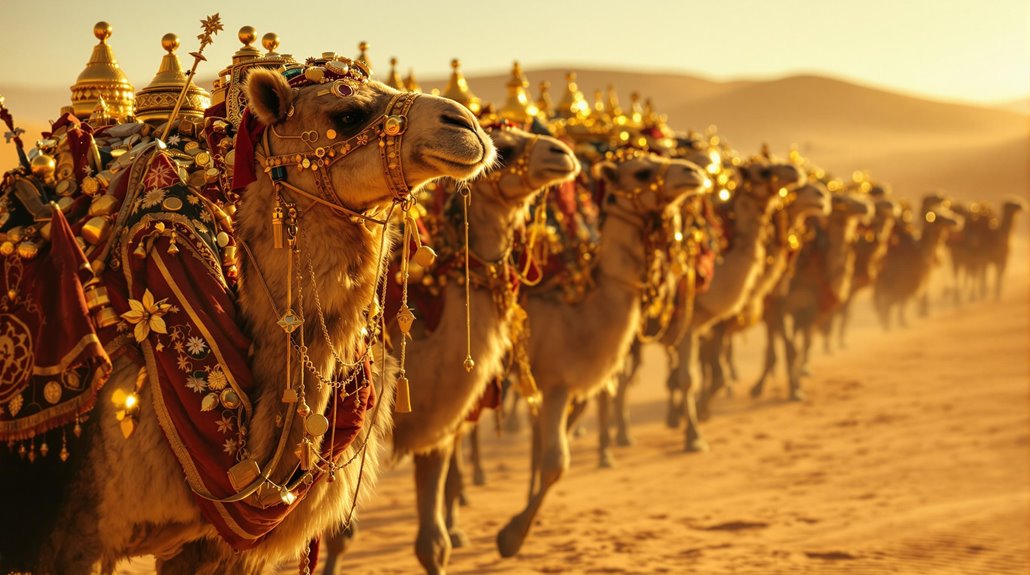Mansa Musa Is Considered History’s Wealthiest Individual
Have you ever wondered what it would feel like to control most of the world's gold supply? You're about to discover how Mansa Musa, the 14th-century African monarch, amassed a fortune that would make today's billionaires look like mere penny collectors. As ruler of the Mali Empire, he didn't just possess wealth—he redefined it. His estimated $400 billion net worth wasn't just numbers on paper; it was enough power to crash entire economies and reshape medieval global trade. Let's explore how one man's riches changed the course of history.
The Empire That Built Unimaginable Wealth

While many empires throughout history amassed great wealth, the Mali Empire stands uniquely positioned as the foundation of Mansa Musa's legendary fortune.
You'll find the empire's prosperity built upon an extraordinary combination of natural resources and strategic advantages. Spanning 2,000 miles across West Africa, Mali controlled vast gold deposits in Bambuk, Boure, and Galam, while also commanding vital trade routes that connected North Africa to sub-Saharan regions.
The empire's agricultural innovations in the fertile Niger River Valley created substantial food surpluses, while salt mines in Taghaza and copper deposits in Takedda diversified its wealth. Under Musa's reign, the empire reached its territorial peak and unprecedented prosperity. Upon returning from his grand pilgrimage to Mecca in 1324, Musa further expanded his realm by conquering the Songhai kingdom.
Mali's sophisticated economic policies, including standardized currency and strategic taxation, transformed these resources into unprecedented riches. Through careful monopolization of the gold trade, the empire effectively controlled global supply and demand.
Measuring Mansa Musa's $400 Billion Fortune
Although calculating historical wealth presents significant challenges, experts estimate Mansa Musa's fortune at a staggering $400 billion in today's money – making him history's wealthiest individual.
His wealth was largely untouched by successors as it diminished within two generations due to invasions and infighting.
When you compare this wealth assessment to modern billionaires, you'll find it's nearly four times greater than Jeff Bezos's $139 billion and dwarfs Bill Gates's $96 billion net worth.
Even combining the fortunes of today's top tech titans doesn't come close to Mansa Musa's inflation-adjusted riches. Only John D. Rockefeller's estimated $340 billion approaches this scale.
His unprecedented wealth came from controlling over 80% of the world's gold supply, vast salt deposits, and strategic trade routes connecting Africa to Asia, Europe, and the Middle East.
Through taxation and conquest of 24 cities, he built an empire whose fortune remains unmatched in human history. His famous pilgrimage to Mecca in 1324 demonstrated this immense wealth, as he distributed so much gold along his journey that he caused significant inflation in the regions he visited.
The Historic Pilgrimage That Crashed Economies
When Mansa Musa commenced on his legendary pilgrimage to Mecca in 1324, he transformed a religious journey into one of history's most extravagant displays of wealth. His pilgrimage impact was so profound that it destabilized entire economies along his route, particularly in Cairo. As the grandnephew of Sundiata, Musa inherited and expanded one of Africa's largest empires. The journey was so grand that his entourage resembled a mobile town as they traversed the desert each night.
You won't believe the scale of his journey:
- Traveled with 60,000 people over 6,000 miles
- Transported 100 camel-loads of gold
- Distributed 20,000 ounces of gold in Cairo alone
- Created economic inflation that lasted 12 years
When Musa attempted to fix the damage by borrowing and repaying gold at high interest rates, he inadvertently caused gold prices to plummet again.
His generosity didn't just crash economies – it put Mali on the map, literally appearing in the 1375 Catalan Atlas and sparking European interest in West African wealth.
Gold, Salt, and Power: Sources of Mali's Prosperity
The foundation of Mansa Musa's legendary wealth rested on Mali's masterful control of two precious commodities: gold and salt.
You'll find it fascinating that Mali controlled nearly half of the Old World's gold trade through its rich deposits in Bambuk, Boure, and Galam. The empire protected its gold interests through a clever silent trade system, while maintaining strict control – gold nuggets remained the exclusive property of the mansa.
Salt's value matched gold in sub-Saharan Africa, with merchants traversing the Sahara to trade at places like Taghaza and Walata. A single camel load of salt could fetch up to 10 mithqals of gold. Under Mansa Musa's reign, Mali reached its golden age of prosperity and cultural influence.
Through strategic positioning along trans-Saharan routes and careful taxation, Mali became an economic powerhouse connecting Africa to Europe, Asia, and the Middle East.
Cultural Legacy of History's Richest Ruler

Beyond amassing incredible wealth, Mansa Musa's most enduring legacy lies in his transformative cultural contributions to West Africa. His commitment to Islamic Education transformed Timbuktu into a global intellectual hub, where the University of Sankore attracted over 25,000 students from across Africa and the Middle East. Under his twenty-five year reign, Mali experienced unprecedented cultural and educational growth. His wealth was largely derived from controlling gold mining operations throughout the empire.
Here's how his cultural impact revolutionized West Africa:
- Built the magnificent Djinguereber Mosque, showcasing innovative Architectural Innovations that still stand today.
- Established vast libraries housing hundreds of thousands of manuscripts.
- Created an extensive network of madrasas that spread education throughout Mali.
- Transformed Mali into a prominent Islamic center by bringing scholars from Cairo.
You can still witness his legacy in Timbuktu's historic buildings and the lasting influence of Islamic scholarship across West Africa.










